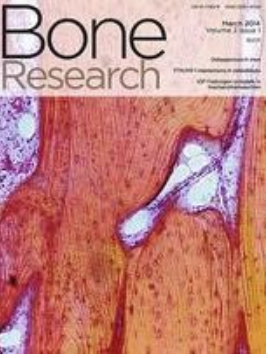Osteoclast-independent osteocyte dendrite defects in mice bearing the osteogenesis imperfecta-causing Sp7 R342C mutation.
IF 15
1区 医学
Q1 CELL & TISSUE ENGINEERING
引用次数: 0
Abstract
Osteogenesis imperfecta (OI) is a group of diseases caused by defects in type I collagen processing which result in skeletal fragility. While these disorders have been regarded as defects in osteoblast function, the role of matrix-embedded osteocytes in OI pathogenesis remains largely unknown. Homozygous human SP7 (c.946 C > T, R316C) mutation results in a recessive form of OI characterized by fragility fractures, low bone mineral density and osteocyte dendrite defects. To better understand how the OI-causing R316C mutation affects the function of SP7, we generated Sp7R342C knock-in mice. Consistent with patient phenotypes, Sp7R342C/R342C mice demonstrate increased cortical porosity and reduced cortical bone mineral density. Sp7R342C/R342C mice show osteocyte dendrite defects, increased osteocyte apoptosis, and intracortical bone remodeling with ectopic intracortical osteoclasts and elevated osteocyte Tnfsf11 expression. Remarkably, these defects in osteocyte function contrast to only mild changes in mature osteoblast function, suggesting that this Sp7 mutation selectively interferes with the function of Sp7 in osteocytes and mature osteoblasts, but not during early stages of osteoblast differentiation. Osteocyte morphology changes in Sp7R342C/R342C mice were not restored by inhibiting osteoclast formation, indicating that dendrite defects lie upstream of high intracortical osteoclast activity in this model. Moreover, transcriptomic profiling reveals that the expression of a core set osteocyte-enriched genes is highly dysregulated by the R342C mutation. Thus, this supports a model in which osteocyte dysfunction can drive OI pathogenesis and provides a valuable resource to test novel therapeutic approaches and to understand the osteocyte-specific role of SP7 in bone remodeling.携带成骨不完全引起的Sp7 R342C突变的小鼠的破骨细胞不依赖骨细胞树突缺陷。
成骨不全症(Osteogenesis imperfecta, OI)是一组由I型胶原蛋白加工缺陷导致骨骼脆弱而引起的疾病。虽然这些疾病被认为是成骨细胞功能的缺陷,但基质嵌入骨细胞在成骨不全发病机制中的作用仍然很大程度上未知。纯合子人类SP7 (C .946 C > T, R316C)突变导致隐性成骨不全,其特征为脆性骨折、低骨密度和骨细胞树突缺陷。为了更好地了解引起oi的R316C突变如何影响SP7的功能,我们产生了Sp7R342C敲入小鼠。与患者表型一致,Sp7R342C/R342C小鼠表现出皮质孔隙度增加和皮质骨矿物质密度降低。Sp7R342C/R342C小鼠表现为骨细胞树突缺陷,骨细胞凋亡增加,皮质内骨重塑,皮质内破骨细胞异位,骨细胞Tnfsf11表达升高。值得注意的是,这些骨细胞功能缺陷与成熟成骨细胞功能的轻微变化形成鲜明对比,这表明Sp7突变选择性地干扰了Sp7在骨细胞和成熟成骨细胞中的功能,而不是在成骨细胞分化的早期阶段。抑制破骨细胞形成并不能恢复Sp7R342C/R342C小鼠的骨细胞形态变化,这表明在该模型中,树突缺陷位于高皮质内破骨细胞活性的上游。此外,转录组学分析显示,一组核心骨细胞富集基因的表达受到R342C突变的高度失调。因此,这支持了骨细胞功能障碍可以驱动成骨不全发病机制的模型,并为测试新的治疗方法和了解SP7在骨重塑中的骨细胞特异性作用提供了宝贵的资源。
本文章由计算机程序翻译,如有差异,请以英文原文为准。
求助全文
约1分钟内获得全文
求助全文
来源期刊

Bone Research
CELL & TISSUE ENGINEERING-
CiteScore
20.00
自引率
4.70%
发文量
289
审稿时长
20 weeks
期刊介绍:
Established in 2013, Bone Research is a newly-founded English-language periodical that centers on the basic and clinical facets of bone biology, pathophysiology, and regeneration. It is dedicated to championing key findings emerging from both basic investigations and clinical research concerning bone-related topics. The journal's objective is to globally disseminate research in bone-related physiology, pathology, diseases, and treatment, contributing to the advancement of knowledge in this field.
 求助内容:
求助内容: 应助结果提醒方式:
应助结果提醒方式:


